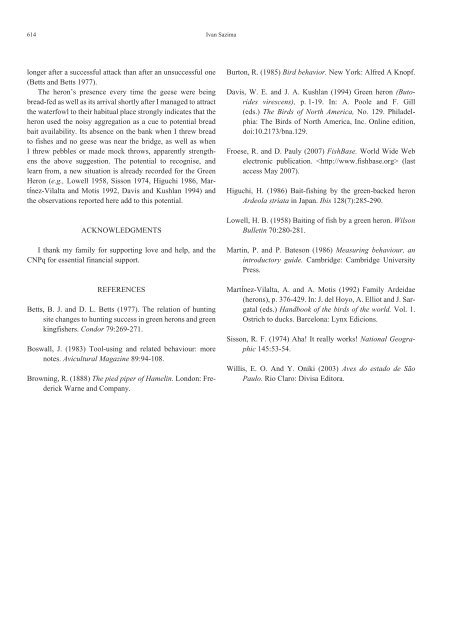Revista Brasileira de Ornitologia - Sociedade Brasileira de Ornitologia
Revista Brasileira de Ornitologia - Sociedade Brasileira de Ornitologia
Revista Brasileira de Ornitologia - Sociedade Brasileira de Ornitologia
You also want an ePaper? Increase the reach of your titles
YUMPU automatically turns print PDFs into web optimized ePapers that Google loves.
614 Ivan Sazima<br />
longer after a successful attack than after an unsuccessful one<br />
(Betts and Betts 1977).<br />
The heron’s presence every time the geese were being<br />
bread-fed as well as its arrival shortly after I managed to attract<br />
the waterfowl to their habitual place strongly indicates that the<br />
heron used the noisy aggregation as a cue to potential bread<br />
bait availability. Its absence on the bank when I threw bread<br />
to fishes and no geese was near the bridge, as well as when<br />
I threw pebbles or ma<strong>de</strong> mock throws, apparently strengthens<br />
the above suggestion. The potential to recognise, and<br />
learn from, a new situation is already recor<strong>de</strong>d for the Green<br />
Heron (e.g., Lowell 1958, Sisson 1974, Higuchi 1986, Martínez-Vilalta<br />
and Motis 1992, Davis and Kushlan 1994) and<br />
the observations reported here add to this potential.<br />
Acknowledgments<br />
I thank my family for supporting love and help, and the<br />
CNPq for essential financial support.<br />
References<br />
Betts, B. J. and D. L. Betts (1977). The relation of hunting<br />
site changes to hunting success in green herons and green<br />
kingfishers. Condor 79:269‐271.<br />
Boswall, J. (1983) Tool-using and related behaviour: more<br />
notes. Avicultural Magazine 89:94‐108.<br />
Browning, R. (1888) The pied piper of Hamelin. London: Fre<strong>de</strong>rick<br />
Warne and Company.<br />
Burton, R. (1985) Bird behavior. New York: Alfred A Knopf.<br />
Davis, W. E. and J. A. Kushlan (1994) Green heron (Butori<strong>de</strong>s<br />
virescens), p. 1‐19. In: A. Poole and F. Gill<br />
(eds.) The Birds of North America, No. 129. Phila<strong>de</strong>lphia:<br />
The Birds of North America, Inc. Online edition,<br />
doi:10.2173/bna.129.<br />
Froese, R. and D. Pauly (2007) FishBase. World Wi<strong>de</strong> Web<br />
electronic publication. (last<br />
access May 2007).<br />
Higuchi, H. (1986) Bait-fishing by the green-backed heron<br />
Ar<strong>de</strong>ola striata in Japan. Ibis 128(7):285‐290.<br />
Lowell, H. B. (1958) Baiting of fish by a green heron. Wilson<br />
Bulletin 70:280‐281.<br />
Martin, P. and P. Bateson (1986) Measuring behaviour, an<br />
introductory gui<strong>de</strong>. Cambridge: Cambridge University<br />
Press.<br />
Martínez-Vilalta, A. and A. Motis (1992) Family Ar<strong>de</strong>idae<br />
(herons), p. 376‐429. In: J. <strong>de</strong>l Hoyo, A. Elliot and J. Sargatal<br />
(eds.) Handbook of the birds of the world. Vol. 1.<br />
Ostrich to ducks. Barcelona: Lynx Edicions.<br />
Sisson, R. F. (1974) Aha! It really works! National Geographic<br />
145:53‐54.<br />
Willis, E. O. And Y. Oniki (2003) Aves do estado <strong>de</strong> São<br />
Paulo. Rio Claro: Divisa Editora.

















